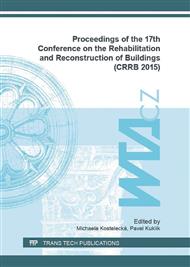p.103
p.107
p.111
p.116
p.122
p.128
p.137
p.143
p.148
Sulfate Attack on Different Types of Concrete in Media Simulating Sewer System
Abstract:
The degradation of concrete due to ingress of sulfate ions from the environment plays an important role in the durability of concrete constructions. Microbiologically induced concrete corrosion (MICC) damages especially sewage collection systems. The most rapid cases of deterioration always occur in areas with elevated H2S concentrations, moisture, and oxygen in the atmosphere. During the MICC, the pH of the surface of concrete sewer pipes is reduced and it may lead to the steel depassivation and results in the corrosion of steel reinforcement. Damage due to a sulfate interaction can result in a cracking and softening, with a loss of strength of concrete. The formation of ettringite (AFt) from gypsum (forming by reaction of sulfate anion with calcium hydroxide) and C3A via monosulfate (AFm) is the main chemical reaction of sulfate attack on concrete. Ettringite and gypsum have considerably larger volume than initial compounds, which leads to increased pressure in concrete. This paper is focused on the sulfate attack on fine-grained concrete where the effect of 0.5% sulfuric acid, simulating MICC, and a solution simulating sewage water has been investigated on changes of the pH, content of sulfates and the porosity in various types of concrete. The aim of this study is to compare the changes in different types of concrete during the sulfate attack in two kinds of medium represented the bottom part of pipelines (waste water) and the sewer crown (0.5% H2SO4). It was found, that after 1 year in 0.5% H2SO4, a visible degradation of surface occurs in all investigated types of concrete. Samples over the year in waste water became dark. Concentration of sulfates in all studied types of concrete increased six times at least after one year sulfuric acid attack and also the reduction of the pH of their aqueous leaches was determined. The solution simulating sewage water did not cause such changes.
Info:
Periodical:
Pages:
122-127
Citation:
Online since:
September 2016
Authors:
Keywords:
Price:
Сopyright:
© 2016 Trans Tech Publications Ltd. All Rights Reserved
Share:
Citation:


